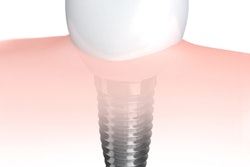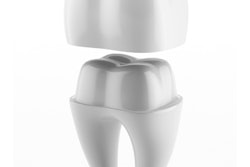
Aluminum, titanium, zirconium, or gold: Which is the best for abutments for implant-supported single crowns? To find out, investigators analyzed previous research, examining survival rates and results for marginal bone loss and discoloration of peri-implant soft tissue for these abutment types.
They searched various databases and included 23 randomized controlled trials, controlled clinical trials, and cohort studies in their network meta-analysis. While many of the findings were similar between the metals, titanium abutments had the best survival rate, aluminum the lowest marginal bone loss, and zirconium the least discoloration of peri-implant soft tissue (Journal of Dentistry, April 12, 2019).
"Based on the results of our network meta-analysis, zirconium might be a recommended abutment material considering the clinical efficacy of implant-supported single crowns," wrote the authors led by Menglong Hu of the prosthodontics department of Sichuan University in Chengdu, China.
Abutment metal muddle
As the structure between the implant and prosthesis, the abutment provides support, prosthesis retention, and help with positioning and rotation prevention, but it can also affect the surrounding soft and hard tissue, according to the authors. Abutments are most commonly made of ceramic or metal, with ceramic having better light transmission and mimicry of natural tooth color and metal being stronger yet in some cases causing discoloration of mucosa around the implant and affecting aesthetics.
“Zirconium might be a recommended abutment material considering the clinical efficacy of implant-supported single crowns.”
The authors reported that the systematic reviews and meta-analyses previously performed regarding abutment material survival rates and complications with implant-supported single crowns have limitations, such as not comparing different abutment materials simultaneously and not including all of the effects of technical, biological, and aesthetic complications.
They conducted the current network meta-analysis to compare the effects of various dental abutment materials when used in implant-supported single crowns on abutment survival, marginal bone loss, and peri-implant soft-tissue discoloration, and to make clinical recommendations for abutment materials. Network meta-analysis allows for multiple treatment comparisons.
Ultimately, the researchers included 23 articles in their analysis that compared abutments made of titanium, zirconium, gold, or aluminum. Fourteen of the studies were randomized controlled trials and nine were controlled clinical trials or prospective or retrospective cohort studies.
Fourteen studies reported differences between titanium and zirconium abutments; six between titanium, zirconium, and gold; two between titanium and aluminum; and one between zirconium and aluminum.
The investigators extracted data from the studies on factors including final follow-up period, intervention, comparison among abutment materials, abutment survival rate, and complications.
Their meta-analysis showed no significant differences between the abutment materials in survival rates, except that aluminum's rate was significantly lower than titanium's (p < 0.05). They found that titanium had the highest probability (97.9%) of having the best survival rate, after which came zirconium (39.4%) and aluminum (12.7%).
They reported that marginal bone loss was significantly lower with zirconium than titanium (p < 0.05) and significantly higher with gold than zirconium (p < 0.05). Aluminum was most likely the best choice for marginal bone loss (81.4%), trailed by zirconium (79.3%), titanium (34.9%), and gold (4.4%).
There were no significant differences between the abutment materials in the discoloration of peri-implant soft tissue. Zirconium had the highest probability of being the best for avoiding discoloration of peri-implant soft tissue (84.8%), followed by gold (55.6%) and titanium (9.6%).
No differences
The authors noted several limitations of their analysis:
- Follow-up time varied.
- Implant location was not mentioned in all studies.
- All studies were not randomized controlled trials.
- Sample sizes were small in some studies.
- The effect of regular oral health maintenance on clinical outcomes was not included in some studies.
They concluded that practitioners should consider what is best for the patient's treatment when deciding which material to use.
"Based on our network meta-analysis, titanium abutments have a similar survival rate with zirconium abutments but better than aluminum abutments," the authors wrote. "In addition, zirconium abutment is better than gold and titanium abutment in terms of maintaining marginal bone. However, there was no difference among the gold, titanium, and zirconium abutments in terms of discoloration of peri-implant soft tissue."



















